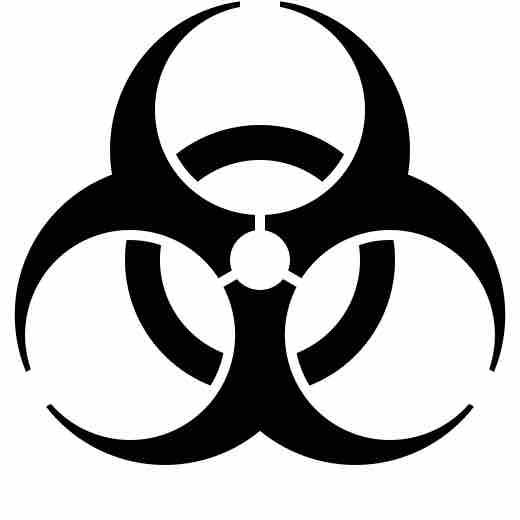Keeping Safe in the Laboratory
Working with microorganisms, especially pathogens, requires special equipment and safety practices. Biological hazards, also known as biohazards, refer to biological substances that pose a threat to the health of living organisms, especially humans. The biohazard symbol is used in the labeling of biological materials that carry a significant health risk, including viral samples and used hypodermic needles .

Biohazard symbol
The international symbol used to label biohazards.
The United States' Centers for Disease Control and Prevention (CDC) categorize various diseases in levels of biohazard: Level 1 being minimum risk and Level 4 being extreme risk. Laboratories and other facilities are categorized as BSL (Biosafety Level) 1-4 or as P1 through P4 for short (Pathogen or Protection Level).
BIOHAZARD LEVEL 1:
Bacteria and viruses including Bacillus subtilis, Escherichia coli, canine hepatitis, varicella (chicken pox), as well as some cell cultures and non-infectious bacteria. Work is generally conducted on open bench tops using standard microbiological practices. At this level, precautions against the biohazardous materials in question are minimal, most likely involving gloves and some sort of facial protection. Decontamination procedures are similar in most respects to modern precautions against everyday microorganisms (i.e., washing one's hands with anti-bacterial soap, washing all exposed surfaces of the lab with disinfectants, etc.). In a lab environment all materials used for cell and/or bacteria cultures are decontaminated via autoclave. Laboratory personnel have specific training in the procedures conducted in the laboratory and are supervised by a scientist with general training in microbiology or a related science.
BIOHAZARD LEVEL 2:
Bacteria and viruses that cause only mild disease to humans, or are difficult to contract via aerosol in a lab setting, such as hepatitis A, B, and C, influenza A, Lyme disease, salmonella, mumps, measles, scrapie, dengue fever, and HIV. BSL-2 differs from BSL-1 in that:
- laboratory personnel have specific training in handling pathogenic agents and are directed by scientists with advanced training;
- access to the laboratory is limited when work is being conducted;
- extreme precautions are taken with contaminated sharp items;
- certain procedures in which infectious aerosols or splashes may be created are conducted in biological safety cabinets or other physical containment equipment.
BIOHAZARD LEVEL 3:
Bacteria and viruses that can cause severe to fatal disease in humans, but for which vaccines or other treatments exist, such as anthrax, West Nile virus, Venezuelan equine encephalitis, SARS virus, tuberculosis, typhus, Rift Valley fever, Rocky Mountain spotted fever, yellow fever, and malaria. Among parasites Plasmodium falciparum, which causes malaria, and Trypanosoma cruzi, which causes trypanosomiasis (sleeping sickness), also come under this level.
Laboratory personnel have specific training in handling pathogenic and potentially lethal agents, and are supervised by competent scientists experienced in working with these agents. All procedures involving the manipulation of infectious materials are conducted within biological safety cabinets, specially designed hoods, or other physical containment devices, or by personnel wearing appropriate protective clothing and equipment. The laboratory has special engineering and design features.
BIOHAZARD LEVEL 4:
Viruses and bacteria that cause severe to fatal disease in humans, and for which vaccines or other treatments are not available, such as Bolivian and Argentine hemorrhagic fevers, Dengue hemorrhagic fever, Marburg virus, Ebola virus, hantaviruses, Lassa fever virus, Crimean-Congo hemorrhagic fever, and other hemorrhagic diseases. Variola virus (smallpox) is an agent that is worked with at BSL-4 despite the existence of a vaccine.
When dealing with biological hazards at this level the use of a positive-pressure personnel suit, with a segregated air supply, is mandatory . The entrance and exit of a Level Four biolab will contain multiple showers, a vacuum room, an ultraviolet-light room, autonomous detection system, and other safety precautions designed to destroy all traces of the biohazard. All air and water services going to and coming from a Biosafety Level 4 (P4) lab will undergo similar decontamination procedures to eliminate the possibility of an accidental release.

BSL-4 hazmat suit
A researcher in a protective suit working with the Ebola virus.